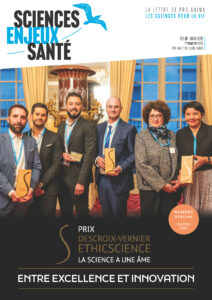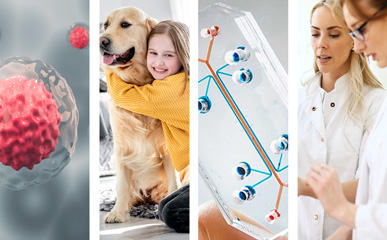
Complement-ARIE Program approved, Publication on Europe’s failure, Julia Fentem awarded MBE and more
News on non-animal methods
Jan 29 - Feb 2, 2024REPORTS & POSITION STATEMENTS
1. Complement-ARIE Program approved by the NIH Council of Councils
On January 25, 2024, the NIH Council of Councils approved the concept of the new NIH Common Fund’s Complement Animal Research In Experimentation (Complement-ARIE) program. The Complement-ARIE program will speed the development, standardization, validation, and use of human-based New Approach Methodologies (NAMs) and will build upon ongoing efforts while identifying opportunities for innovation and coordination.
Complement-ARIE will significantly advance understanding of human health and disease by providing a range of ready and standardized biomedical research models. Developing these models will require expertise in disease research, personalized medicine, and in screening therapeutics for safety and effectiveness.
2. New publication exposes Europe’s failure to uphold legal requirement of chemical testing on animals as a ‘last resort’
A new paper published this month in Regulatory Toxicology and Pharmacology by Unilever, Procter & Gamble, Innospec and other members of the Animal-Free Safety Assessment Collaboration (AFSA) has exposed numerous concrete examples of acceptance barriers to companies’ good-faith attempts to honour the requirement under European chemicals law that new animal testing may only be undertaken “as a last resort.”
The peer-reviewed article, “The last resort requirement under REACH : from principle to practice,” also provides recommendations to enhance the governance and enforcement of the legal requirement established in the EU Registration, Evaluation, Authorisation and Restriction of Chemicals (REACH) regulation. If implemented, the AFSA suggestions would significantly advance science and animal welfare by helping to inform upcoming plans to revise REACH and develop an EU roadmap for phasing out animal testing in the chemicals and other regulated product sectors.
3. Towards in vitro models for reducing or replacing the use of animals in drug testing, by the IQ Consortium
In the FDA Modernization Act 2.0, which became effective in December 2022, the United States Food and Drug Administration (FDA) stated that New Approach Methodologies (NAMs) may be used to reduce or replace conventional animal studies, where appropriate. In vitro NAMs as alternatives to animal use have been steadily adopted over the past several decades. NAMs, and in particular microphysiological systems (MPSs), are rapidly increasing in physiological relevance and complexity. The FDA Modernization Act 2.0 should help spur their further development.
Expecting the path to validation, routine regulatory acceptance and eventual widespread deployment to be gradual and to span decades, members of the International Consortium for Innovation and Quality in Pharmaceutical Development (IQ) published a comment in the journal Nature Biomedical Engineering where they strongly support expanding relevant alternative testing options that can be used in new drug applications to the FDA to justify that a therapeutic can be safely evaluated in human trials. They observed that overall the groundswell of support and funding for these new approaches is encouraging, and they envision that, with increasingly robust qualification and with advances in automation, a gradual adoption of in vitro NAMs over the next few decades will increasingly reduce the need for animal studies.
INTERVIEWS, NOMINATIONS & AWARDS
4. Julia Fentem awarded MBE (Member of the order of the British Empire)
Congratulations to Julia Fentem, Unilever Global Head of Safety, Environmental & Regulatory Science, who has been awarded an MBE in the King’s New Year’s Honours list in recognition of her services to human health and animal welfare. Julia, who joined Unilever 25 years ago, has led and accelerated Unilever’s work to develop non-animal safety science, propelled by her deep commitment to helping to bring an end to animal testing for all consumer products anywhere in the world.
Julia’s MBE recognises the impact she has also had beyond Unilever, advocating alternatives to animal testing globally and for the changes to policy and legislation needed to end animal testing of chemicals completely.
5. Dr. David Brenner, president, Sanford Burnham Prebys medical research institute in La Jolla : “Working with actual human cells and tissues is much more likely to directly inform medical research”
Liver disease is among the most common conditions in the United States. More than 100 million Americans have some form, mostly fatty liver disease, that can, if undetected and untreated, lead to cirrhosis and liver cancer. Chronic liver disease and cirrhosis are the ninth-leading causes of death in the United States, and rising.
In his field of study, hepatology, Dr Brenner explains that the researchers explore a variety of alternatives to animal testing to find desperately needed new drugs for the treatment of liver diseases. These range from precision-cut liver slices kept alive in culture to organoids (clusters of developing cells that re-create in miniature the structure and functions of organs) to bioprinted cellular systems and sustainable 3D structures (liver on a chip).
INDUSTRY, BIOTECH & PARTNERSHIPS
6. Top 5 Innovators to Watch in 2024 according to the Center for Contemporary Sciences (CCS)
CCS evaluated more than 150 companies and organizations developing or working with human-relevant technology for biomedical research and drug development. Companies evaluated include pharmaceutical, in vitro, in silico, and chemical companies. CCS determined 4 criteria : community recognition, entire system modeling, applications and entirely animal-free.
They identified the top 5 companies that have, according to the Center, the most significant impact on human-relevant research thus far and should be watched in the upcoming year.
7. Biotechs Dynamic42 and Biopredic join for strategic marketing agreement
The innovative organ-on-chip specialist Dynamic42 GmbH and Biopredic, manufacturer of assay systems for research, announce a strategic marketing agreement. The joint partnership aims to advance the development of in vitro assay systems by using human-relevant models in the early phase of drug development.
The collaboration combines Dynamic42’s extensive know-how in the development of miniaturized human organ models (so-called organ-on-chip models) for drug testing using HepaRG™, the unique human hepatic cell model produced by Biopredic.
8. FluoSphera is awarded a CHF 1.1 million grant from Innosuisse
FluoSphera S.A., a biotechnology company developing versatile and disruptive in vitro solutions for drug discovery to predict drug efficacy and safety under systemic conditions, announced that its new innovation project together with EPFL and the University of Geneva (UNIGE) has been awarded a grant of CHF 1,100,000 Swiss francs from Innosuisse, the Swiss Innovation Agency.
The proposed research will generate multiplexed data that can predict human response with greater accuracy and precision than conventional cell culture or animal-based experimental testing. And importantly, the project will demonstrate how the FluoSphera technology platform can significantly reduce the risk of drug discovery and increase the probability to identify the right candidate drugs before reaching human clinical evaluation and thus, dramatically impact the cost and timelines to bring safe and effective medicines to patients in need.
9. $500 million licensing deal between Italy’s Menarini and Insilico Medicine
Earlier this month, Insilico entered into an agreement that could be worth more than $500 million to license a potential breast cancer drug to Stemline Therapeutics, a subsidiary of Menarini. Under the deal, Stemline Therapeutics will have exclusive global rights to develop and sell a novel molecule that could be made into treatment for cancers.
The startup is currently working on 31 AI-discovered drug candidates in areas including cancer and fibrosis. Its lead candidate, a potential drug for idiopathic pulmonary fibrosis, an incurable lung disease, is in mid-stage human trials in the U.S. and China. In September, Insilico sold the rights to develop and commercialize a potential cancer drug to Nasdaq-listed Exelixis for an upfront payment of $80 million.
TOOLS, PLATFORMS, CALLS
10. Launch of the FC3R Short Notes
The FC3R Short Notes Platform is a tool for disseminating unpublished positive or negative results. Researchers are invited to submit their scientific results in order to participate in more transparent and robust research, and to allow access to data that has not been visible until now.
Short Notes are brief articles written in English, limited to 2,000 words and 2 figures. Eligible studies include original research or replications with any type of results : positive, negative, or inconclusive. Each Short Note undergoes a rapid evaluation and validation process, after which a Digital Object Identifier (DOI) is assigned to increase its visibility. The scope of FC3R Short Notes is not confined to animal experiments ; it also encompasses non-animal studies that promote the 3Rs in research. The data from an FC3R Short Note remain available for future submission to a peer-reviewed journal.
11. Call Horizon Europe : Gaining experience and confidence in NAMs for regulatory safety and efficacy testing – coordinated training and experience exchange for regulators
There is increasing scientific evidence pointing to the limitations of animal testing for safety and efficacy assessment of chemicals and pharmaceuticals. Europe is also experiencing a strong societal demand to move away from animal testing. Scientific progress of the past two decades has produced a number of animal-free New Approach Methodologies (NAMs) that have the potential to be used instead of the animal models that are currently employed for such testing. However, knowledge, experience and confidence on how results from the NAM assays could be used is still lacking among regulators, which could limit the industry’s use of NAMs because of lack of legal certainty when generating safety and health data requested by EU legislation.
As part of the competitive health-related industry objective, Horizon Europe is calling for proposals that should focus on alternatives to the use of animals for regulatory safety and efficacy testing.
Deadline : 2024, Apr. 11
Budget : €2 000 000
SCIENTIFIC DISCOVERIES & PUBLICATIONS
12. A systems toxicology approach for identification of disruptions in cholesterol homeostasis after aggregated exposure to mixtures of perfluorinated compounds (PFAS) in humans
Per- and polyfluoroalkyl substances (PFAS) are used in various household and industrial products. In humans, positive associations were reported between PFAS, while animal studies show the opposite. Human-centered approaches are needed to better understand the effects of PFAS mixtures on cholesterol.
A new systems toxicology approach was developed by Rob Sterium and colleagues from Netherlands Organisation for Applied Scientific Research TNO. This approach consists in using a gene-centered cholesterol biokinetic model ; existing PFAS physiologically based kinetic model augmented with lung and dermal compartments and populated with data reflecting lifetime mixture exposure.
Using a human-centered computational approach, the effects of aggregated lifetime PFAS exposure on cholesterol homeostasis clearly distinguished background exposures versus high occupational exposures, and helped to identify occupational subgroups at potential risk. The approach may help to develop human-based quantitative health risk assessment approaches for PFAS, unlikely to be achieved by animal and epidemiological studies alone.
13. ‘Kirigami’ electrodes unfold new horizons for brain organoid research
Inspired by Japanese paper art, a new device can record from 3D ‘organoid’ models of the developing human brain for months without disturbing their growth or structure.
Realizing the full potential of organoids and ‘assembloids’ to model neural development and disease will require improved methods for long-term, minimally invasive recording of electrical activity. Current technologies do not allow chronic recording of organoids in suspension, which is necessary to preserve architecture.
Inspired by kirigami art, researchers developed flexible electronics that transition from a two-dimensional to a three-dimensional basket-like configuration with either spiral or honeycomb patterns to accommodate the long-term culture of organoids in suspension. In an article published in Nature Biotechnology in January 2024, the team shows that this platform, named kirigami electronics (KiriE), integrates with and enables chronic recording of cortical organoids for up to 120 days while preserving their morphology, cytoarchitecture and cell composition. (…) KiriE will enable investigation of disease and activity patterns underlying nervous system assembly.
The study was spearheaded by Wu Tsai Neuro Interdisciplinary Postdoctoral Scholar Xiao Yang and Cui lab postdoc Csaba Forro.
14. Digital replicas of patients can help them get healthy
Simulations of the human body and advanced data promise more personalised medical treatment for a range of illnesses. By testing methods and drugs on “digital twins”, medical staff can determine the best courses of treatment for the patients themselves.
‘We definitely don’t want to do trial and error on the patient, but with a digital twin we can try the surgery many times,’ said Biancolini, an associate professor of machine design at the University of Rome. He leads a research project that received EU funding to train early-stage researchers in the potentially wide range of uses of digital twins for the treatment and prevention of aneurysms. These afflictions can be present in people from birth or result from conditions including high blood pressure, fatty plaques and trauma.


